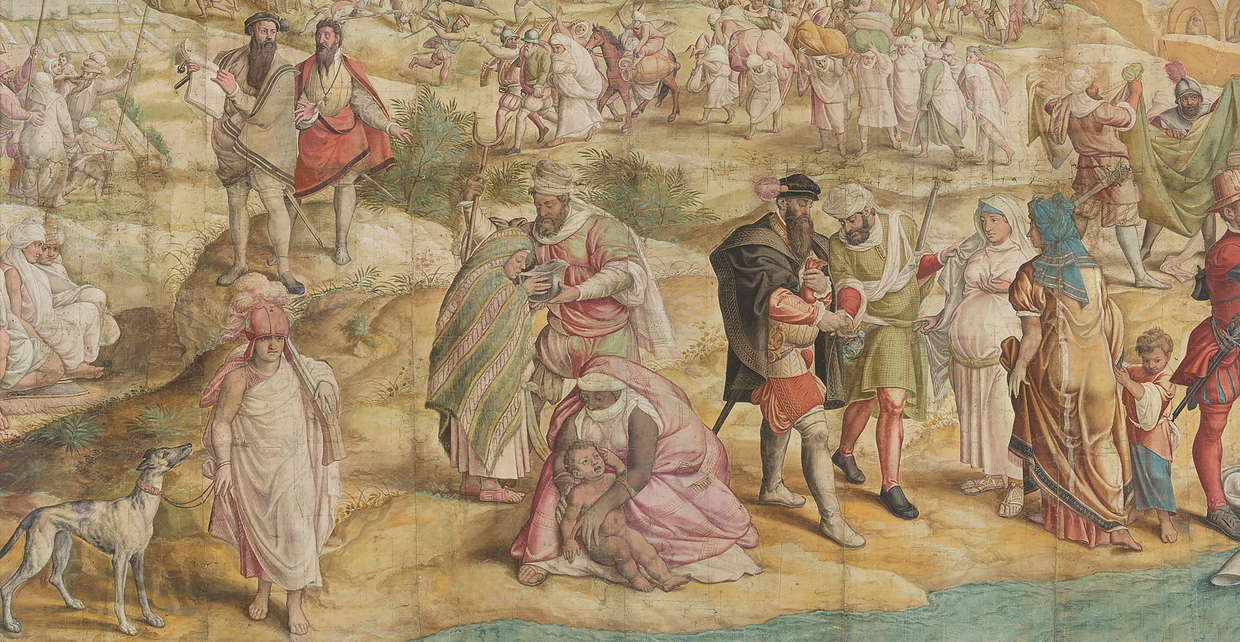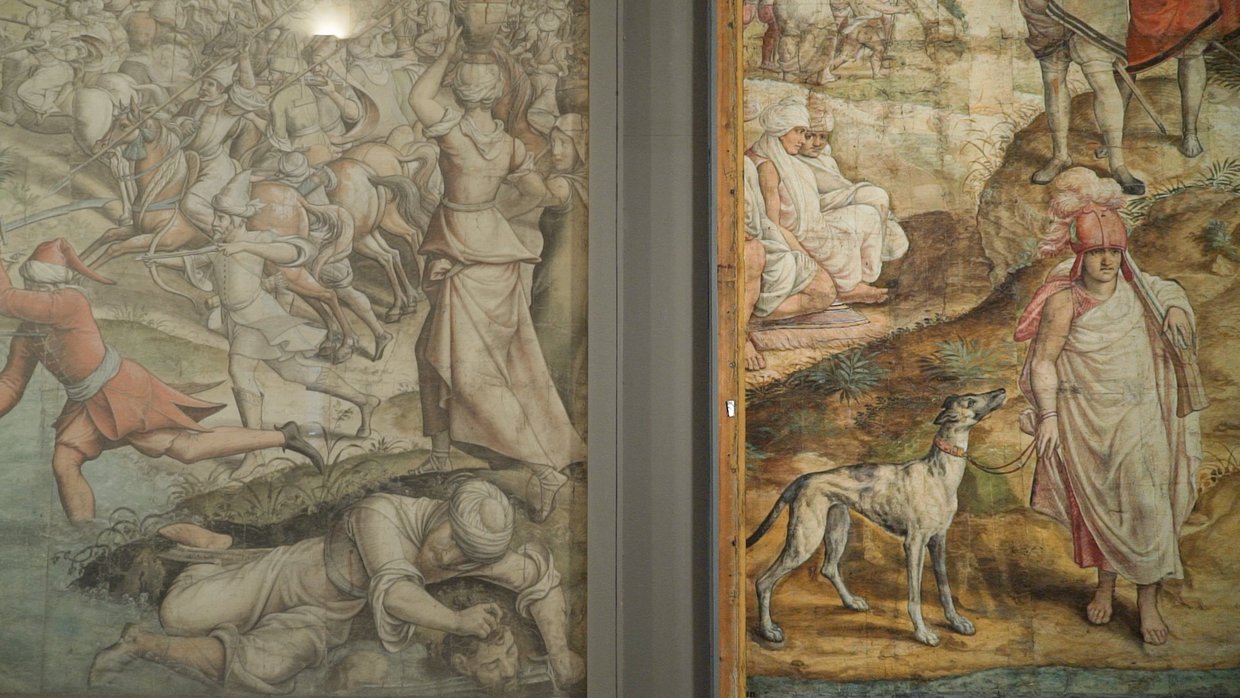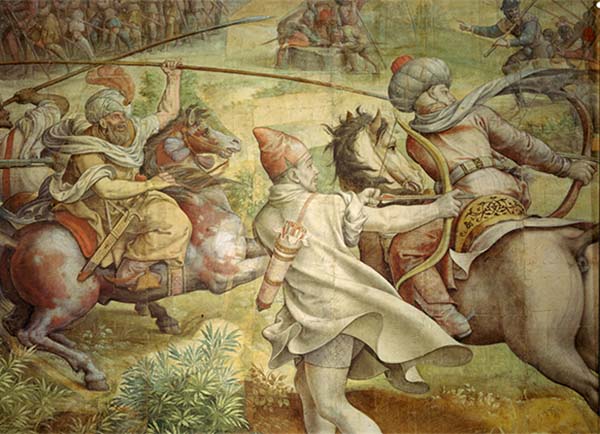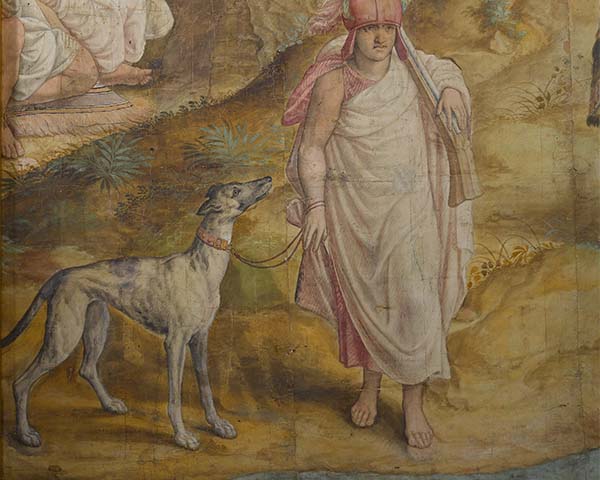
Vermeyen cartoons
Let us preserve one of the greatest treasures of the Renaissance!
Works of art are made to last forever. Unfortunately, the materials they are made of are not.
Let us preserve one of the greatest treasures of the Renaissance!
Research and restoration project
The ten-part cardboard cycle depicting the campaign of Charles V to Tunis by Jan Cornelisz. Vermeyen is one of the most important works in the collection of the Kunsthistorisches Museum. In 2018, thanks to the support of the René and Karin Jonckheere Fund of the King Baudouin Foundation, the Flemish government, and numerous donors, it was possible to begin the extensivee research and restoration project on Vermeyen's important tapestry designs. A lot has happened since then:
In order to assess the condition of the cartoons, The Conquest and Pillage of Tunis was selected as part of a pilot project. The protective glass had to be removed - no easy task due to the huge dimensions of the cartoon.

Thanks to a large number of donations that we were able to raise for the project during an initial campaign in 2018, two restorers have since been commissioned to carry out the examinations and initial conservation measures on the cartoons directly on site.
The cartoon was closely examined and digitized with the help of infrared images and grazing light. After cleaning the surface, the restorers secured the endangered parts of the cartoon and fixed loose colour pigments.

This year, the new presentation of the conserved cartoon is on the agenda. For this purpose, we need a new vitrine that not only meets current exhibition standards, but should also provide an improved visual experience. The green tint of the old vitrine currently causes a significant deviation from the original colours of the cartoon. This difference in colour is particularly noticeable when comparing an adjacent cartoon with old glass and the currently unglazed cartoon of the pilot project.

Our goal is that the cartoon The Conquest and Pillage of Tunis can be experienced again in all its colourful glory behind a new vitrine!
Thanks to the commitment of numerous donors, we have succeeded in raising the required total of over € 80,000 for the purchase of the new vitrine!
From the bottom of our hearts we thank all supporters who made this possible!
Want to learn more about the fascinating series of the Vermeyen cartoons? We invite you to learn more about the unique tapestry designs here!
Why is the Vermeyen cycle so exceptional?
The cycle commissioned by Charles V from Jan Cornelisz. Vermeyen was regarded early on as a work of art in its own right. Since the cartoons were models for tapestries, this was not self-evident. The material of these masterpieces is exceedingly fragile and tapestry cartoons were not always seen and kept as paintings in their own right. The Kunsthistorisches Museum's monumental Vermeyen cartoons are unique in the world due to their size of approximately 310 m² and their state of preservation.
"Vermeyen's cartoons for the monumental tapestry cycle of Emperor Charles V's campaign against Tunis constitute the largest holdings of Dutch Renaissance tapestry originals in the world.
The cartoons for this most important, extensive, and expensive prestige project in the service of Emperor Charles V's propaganda constitute a unique work of the very highest order from an artistic, cultural-historical, and historiographical perspective."
Sabine Pénot, Curator

The Conquest and Pillage of Tunis
The cartoon selected for the pilot project The Conquest and Pillage of Tunis is one of ten tapestry cartoons that still exist - originally it was a twelve-part cycle. In order to recreate the scenes as accurately as possible, Vermeyen was commissioned by Emperor Charles V to personally participate in the campaign to Tunis and to document the events on site.
From countless sketches Vermeyen thus created the series of tapestry designs between 1546 and 1550. They depict the victory of the Habsburgs in a propagandistic manner and there is much to discover on the monumental work (3.85 × 7.12 m).
In the midst of the sweeping landscape, diverse scenes of this pivotal episode of the campaign play out simultaneously. In the background, the vastness of the city of Tunis can be seen. The accuracy of the depiction reveals that Vermeyen has incorporated the sketches made on the spot extremely accurately.

The Vermeyen cartoons at the Kunsthistorisches Museum
The importance of the Vermeyen cartoons can be seen in this sensational episode: on February 8, 1822, the custodian Josef Rosa the Younger reported to the K & K Oberstkämmereramt that the English captain Sir Henri Thomson had offered 10,000 pounds sterling for the purchase of the Vermeyen cartoons. This was significantly more money than the artist himself had ever received for the creation of the cartoons. However, this offer was explicitly rejected.
Even during the construction of the Kunsthistorisches Museum, the Vermeyen cartoons were included in the room and lighting concept. When the Kunsthistorisches Museum opened in 1891, the Vermeyen cartoons were exhibited in the Primary Gallery, where Emperor Franz Joseph I could admire them in person. Due to later redesigns, they made a stop in the Bassano Hall until 1928, when they were moved to the 2nd floor corridor, which is less than ideal for viewing the monumental tapestry designs. They can still be admired there today.

The Vermeyen cycle during the world wars
At its location on the 2nd floor of the Kunsthistorisches Museum, the cycle of the Vermeyen cartoons survived both world wars. A bomb hit in the museum's dome during World War II unfortunately did not leave the valuable cartoons unscathed. Several vitrines shattered and the efforts to purchase new vitrines after the war were in vain, as hardly any glass was available. Parts of the cartoons were thus unprotected for years - a disaster from a conservational point of view! It was not until 1955 that new vitrines could be purchased, but its quality no longer meets today's standards of preservation and reduces the viewing experience due to a strong green tinge.

Information
Your donation is tax-deductible
account holder: KHM-Museumsverband
IBAN: AT70 6000 0005 1014 1679
BIC: BAWAATWW
reference: Donation Vermeyen cartoons
For more information, please contact
Sandra Eichinger, BA
+43 1 52524 - 4038
spende@khm.at






